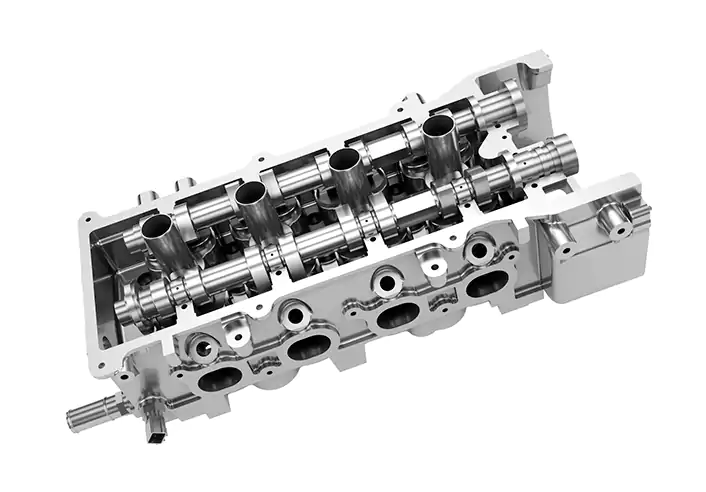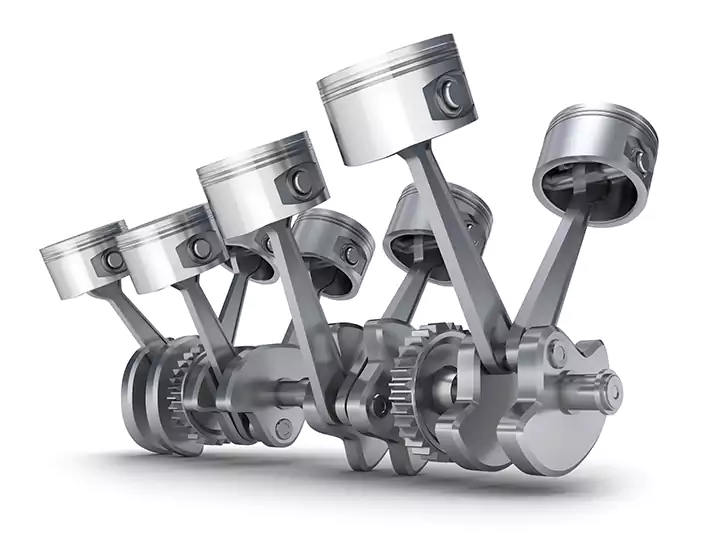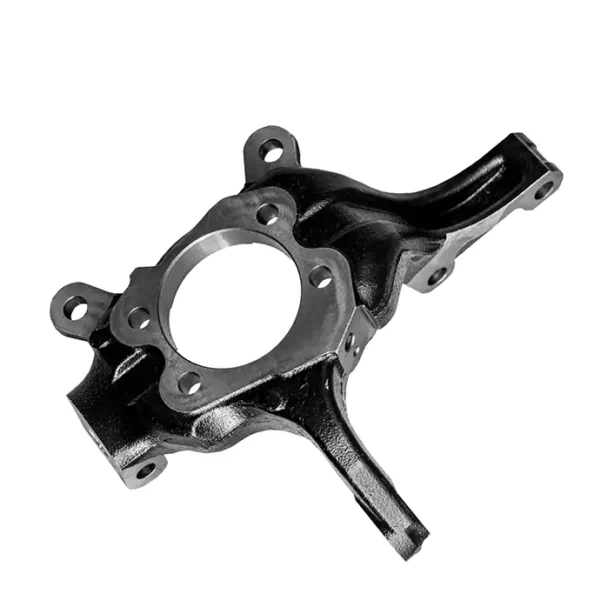CNC Machining in Automotive: Diverse Applications, Advantages
CNC machining, or computer numerical control machining, is a manufacturing process that utilizes pre-programmed computer software to control machine tools and operate complex machinery. The automotive industry is one of the largest consumers of CNC machining services due to its ability to produce high-quality, precise, and consistent vehicle parts that meet the industry’s stringent requirements.
In this article, we explore the various applications of automotive machining and its many advantages over traditional manufacturing methods.
Advantages of CNC Machining in the Automotive Industry
1. Higher precision and accuracy
One of the main advantages of using CNC precision machining in the automotive industry is its ability to produce precision machined parts. CNC machines are designed to follow extremely precise instructions and produce parts of consistent shape, size, and quality. This level of precision is critical in the automotive industry, where car parts need to meet stringent requirements to ensure safety and reliability.
2. Increased efficiency and productivity
CNC machining is a highly efficient manufacturing process that enables automotive manufacturers to produce parts at a much faster rate than traditional methods. CNC machines can work continuously for hours, with minimal downtime and maintenance, which significantly increases production rates and reduces lead times.
3. Consistency and Repeatability
It is known for its high level of consistency and repeatability. Once a CNC machine is programmed, it can produce identical parts repeatedly, with little to no variation in quality or specifications. This level of consistency is critical in the automotive industry, where parts need to meet strict quality control standards and comply with regulatory requirements.
4. Greater Design Flexibility
Another advantage of using CNC machining in the automotive industry is its ability to produce complex and intricate parts with a high degree of accuracy. CNC machines can produce parts with various shapes, sizes, and designs, making it easier for automotive manufacturers to meet the design requirements of their customers.
5. Improved Safety and Reduced Risk of Errors
CNC machines are automated and require minimal human intervention, reducing the risk of human error and improving safety in the workplace. This is especially important in the automotive industry, where worker safety is a top priority.
CNC Machined Automotive Components
1. Engine Components
CNC machining is used extensively in the production of engine components in the automotive industry. These functional components include cylinder heads, pistons, connecting rods, crankshafts, and engine blocks. CNC machines are used to produce these parts to very tight tolerances, ensuring they perform as expected and precisely.

Cylinder Heads
Cylinder heads are critical components of an engine, and CNC machining is used to produce them to precise specifications. CNC machines are used to create the intricate designs and shapes required for proper combustion and airflow, resulting in improved engine performance and efficiency.
Pistons

Pistons are another critical engine component that requires high precision and accuracy. CNC machines are used to create intricate shapes and designs, making sure the pistons fit perfectly into the engine block and move smoothly during combustion.
Connecting Rods
Connecting rods are responsible for connecting the piston to the crankshaft and transferring the force generated during combustion to the crankshaft. CNC machining is used to create connecting rods that are strong, lightweight, and precisely designed to fit within the engine.
Crankshafts
The crankshaft is responsible for converting the up and down motion of the pistons into rotational motion, which drives the vehicle’s wheels. CNC machining is used to produce high-precision crankshafts, ensuring they run smoothly and efficiently.
Engine Blocks
CNC machines are also used to produce engine blocks, which house all the engine components. Engine blocks need to be precise and consistent to ensure that the engine operates reliably and efficiently.
2. Suspension Component

It is also used to produce suspension components for the automotive industry. These components include control arms, knuckles, spindles, and support frames. CNC machining is used to produce high-quality parts with top precision, resulting in better handling and higher ride quality.
Control Arms
Control arms are responsible for connecting the suspension to the chassis and allowing the suspension to move up and down. It is used to produce control arms with complex shapes and designs, resulting in improved handling and stability.
Knuckles

Knuckles are responsible for connecting the wheels to the system and allowing them to move up and down. CNC machining is used to produce knuckles with high precision and accuracy, ensuring that they fit perfectly and operate smoothly.
Spindles
Spindles are critical components of the suspension system that connect the upper and lower control arms and support the weight of the vehicle. CNC machining is used to produce spindles to very tight tolerances, ensuring that they can handle the weight of the vehicle and provide a smooth ride.
Strut Mounts
Strut mounts are responsible for connecting the strut to the chassis of the vehicle. CNC machining is used to produce strut mounts with high accuracy and precision, ensuring that they fit perfectly and provide a smooth and stable ride.
3. Transmission Components
CNC machining is also used to produce transmission components in the automotive industry. These components include gears, shafts, and housings. It is used to produce these parts with high precision and accuracy, resulting in a smooth and efficient transmission system.

Gears
Gears are responsible for transmitting power from the engine to the wheels of the vehicle. CNC machining is used to produce gears with high accuracy and precision, ensuring that they fit perfectly and operate smoothly.
Shafts
Shafts are critical components of the transmission system that transfer power from the engine to the gears. CNC machining is used to produce shafts with high precision and accuracy, ensuring that they fit perfectly and operate smoothly.
Housings
Housings are responsible for protecting the gears and other components of the transmission system. CNC machining is used to produce housings to very tight tolerances, ensuring that they fit perfectly and provide the necessary protection.
4. Brake Components
CNC machining is also used to produce brake components in the automotive industry. These components include brake calipers, rotors, and pads. It is used to produce high-precision parts, resulting in better braking performance and safety.
Brake Calipers
Brake calipers are responsible for applying pressure to the brake pads, which then press against the rotor to slow down the vehicle. CNC machining is used to produce brake calipers with high precision and accuracy, ensuring that they apply the necessary pressure to the brake
Rotors
Rotors are circular metal discs that the brake pads press against to slow down or stop the vehicle. CNC machining is used to produce rotors to very tight tolerances, ensuring that they are perfectly round and have a smooth surface. This results in better braking performance and reduced noise and vibration.
Pads
Brake pads are the components that press against the rotors to slow down or stop the vehicle. CNC machining is used to produce brake pads with high precision and accuracy, ensuring that they fit perfectly and provide optimal friction and wear resistance.
5. Chassis Components
CNC machining is also used to produce chassis components in the automotive industry. These components include frame rails, cross-members, and suspension mounts. It is used to produce these parts with high precision and accuracy, resulting in a stronger and more stable chassis.
Frame Rails
Frame rails are the long metal beams that form the backbone of the vehicle’s chassis. CNC machining is used to produce frame rails with high precision and accuracy, ensuring that they are straight, strong, and able to support the weight of the vehicle.
Cross-members
Cross-members are metal beams that connect the frame rails and provide additional support to the chassis. It is used to produce cross-members with high precision and accuracy, ensuring they fit perfectly and provide the necessary support.
Suspension Mounts
Suspension mounts are responsible for connecting the suspension system to the chassis. CNC machining is used to produce suspension mounts with high accuracy and precision, ensuring that they fit perfectly and provide optimal stability and support to the suspension system.
Differences between Traditional Machining and CNC Machining
Traditional machining refers to the manufacturing process of shaping, cutting, drilling, and finishing materials into a desired shape using manual or semi-automatic methods. These methods include lathes, mills, drills, saws, and grinders. Traditional machining typically involves a skilled operator who performs the machining operations by controlling the tool movement and material feed rate.
CNC machining, on the other hand, uses a computer-controlled process to automate machining operations. These machines are programmed with a design file that specifies the toolpath, cutting speed, and material feed rate. This allows for a high degree of precision and accuracy, and the machine can run continuously without constant human intervention.
Some key differences between traditional and CNC machining include:
Operator Skill: Traditional machining requires a skilled operator who can perform the machining operations manually, while CNC machining can be operated by less skilled personnel who only need to program the machine.
Flexibility: Traditional machining is more flexible than CNC machining, as it allows for manual adjustments to be made during the machining process. CNC machining is limited to programming and design files.
Precision and Accuracy: CNC machining is generally more precise and accurate than traditional machining due to computer-controlled automation.
Consistency and repeatability: CNC machines can produce identical parts with high consistency and repeatability, ensuring quality control.
Reduced labor costs: CNC machines require less skilled labor than traditional machining, resulting in lower labor costs.
Role of CNC Machining in Design and Prototyping
Design and prototyping are essential in the automotive industry as they allow automakers to test and refine designs before bringing them to market. This helps ensure that the final product meets the required specifications and quality standards.
CNC machining plays a vital role in the design and rapid prototyping process as it allows automakers to produce accurate and precise prototypes quickly and efficiently. This allows for faster and more cost-effective design changes, saving time and resources.
There are several advantages of using CNC machining in the design and prototyping process, including:
Faster prototyping: It can produce accurate and precise prototypes quickly, allowing for faster design iterations.
Reduced costs: CNC machining allows for design changes to be made more quickly and cost-effectively, reducing the overall cost of the design and prototyping process.
Improved accuracy and precision: CNC machining can produce highly accurate and precise prototypes, resulting in a more accurate representation of the final product.
How to Find the Automotive Machining Services that Work Best for You
For businesses in the automotive industry, choosing the right auto machining service is critical to their success. To ensure you find the best service for your specific needs, it is essential to conduct thorough research and compare the capabilities of different companies.
When evaluating potential automotive manufacturing service providers, consider several key factors. Look for companies with a proven track record of success in the industry, as this is a good indicator of their reliability and expertise. Customized solutions and fast turnaround times are also key considerations.
A prominent company in this field is Capable Machining. With its cutting-edge CNC machines and team of experienced professionals, Capable Machining offers a wide range of automotive manufacturing services meeting the strictest standards of quality and precision.
Conclusion
CNC machining has revolutionized the automotive industry by providing fast, accurate and cost-effective production of complex components. The use of CNC machines allows for tighter tolerances, greater precision, and greater consistency in the production of critical automotive applications such as engines, suspensions, transmissions, brakes, and chassis components. CNC machines are also used to create custom automotive parts for high-performance vehicles, such as race cars and sports cars. Overall, the various applications of CNC machining make the automotive industry more efficient, productive, and innovative.